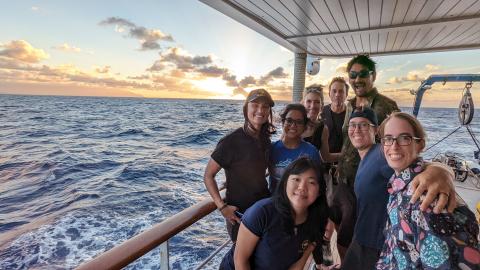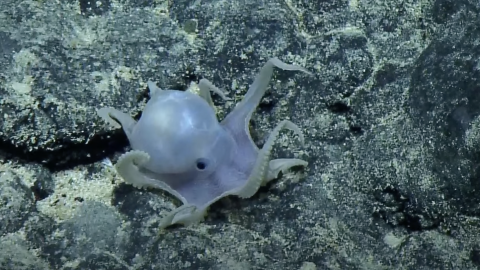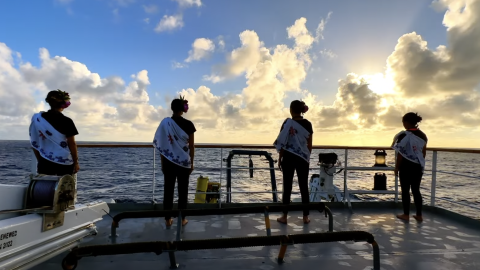Deep Sea Dreams: A Journey Into Pō and Back
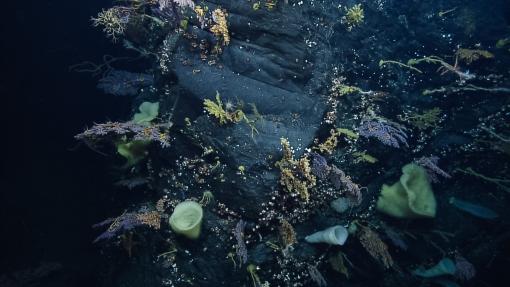
This blog is written by Daniel Kinzer, Lead Science Communication Fellow of the Ala ʻAumoana Kai Uli expedition and Lead Community Technologist for Purple Maiʻa Foundation
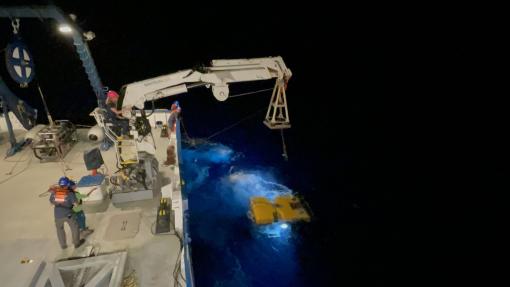
ROV Hercules being released into the depths.
We stand above as Hercules is slowly released into the ocean.
Far from any land.
Miles of ocean beneath us.
Maybe a sunken aircraft carrier, or an ancient volcano. The ocean folds into a spectrum of blues as Hercules touches the water. It is my favorite color. Another dream begins, and we enter the cave of the control van.
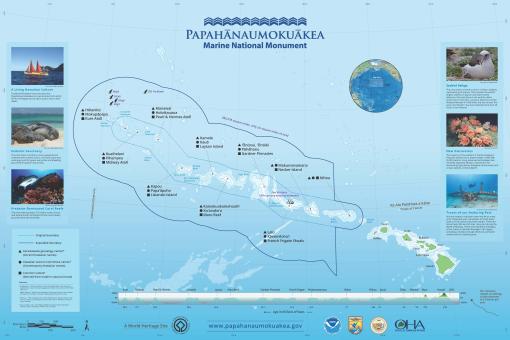
The Ala ʻAumoana Kai Uli voyage would take us to the furthest northwest edges of Papahānaumokuākea and back.
I’m the lead Science Communication Fellow on board E/V Nautilus - the dedicated deep-sea exploration ship operated by Ocean Exploration Trust (OET) - for this special expedition into the sacred waters of Papahānaumokuākea Marine National Monument.
Hercules, our hero, is a very large remotely operated vehicle (ROV), but seemingly alive and well. Along with its trusty partner Atalanta, they will be our ROVs for exploring ancient deep-sea volcanoes, the life that covers their slopes, as well as three World War II shipwrecks sunk in the historic Battle of Midway, and the life we honor by telling their stories. It’s my job onboard to help facilitate the deep sea storytelling from my chair inside the control van.
The control van is cold and dark; or at least it would be if it weren’t for the over 30 screens glowing throughout the room. Red lights create a haunting glow. Our wandering conversations become just another vehicle for transporting new friends and collaborators into a sacred realm.
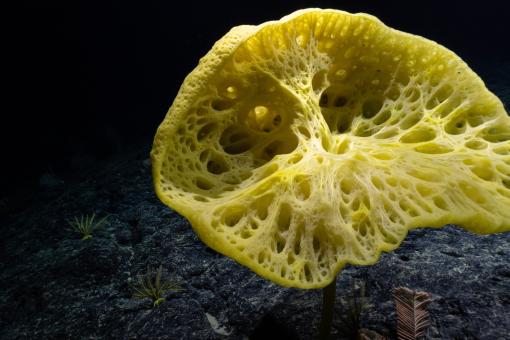
An other-worldly Bolosoma sp. glass sponge
Discussion of food, pets, music, travel, culture, ‘ōlelo Hawaiʻi words of the day - even SpongeBob references - were interspersed between the frequent sounds of awe, wonder, discovery, and valiant attempts at identification of what we’re seeing in this never before seen realm.
“Was that a Bolosoma or a Caulophacus sponge?”
“Did you see that radial fracturing?”
“Let’s remember the times of joy and celebration experienced by the many sailors on these shipwrecks. Like us, they became family at sea.”
“Can we get a zoom on that bamboo (coral)?”
“Chaunocops!”
Sometimes, we just fell silent.
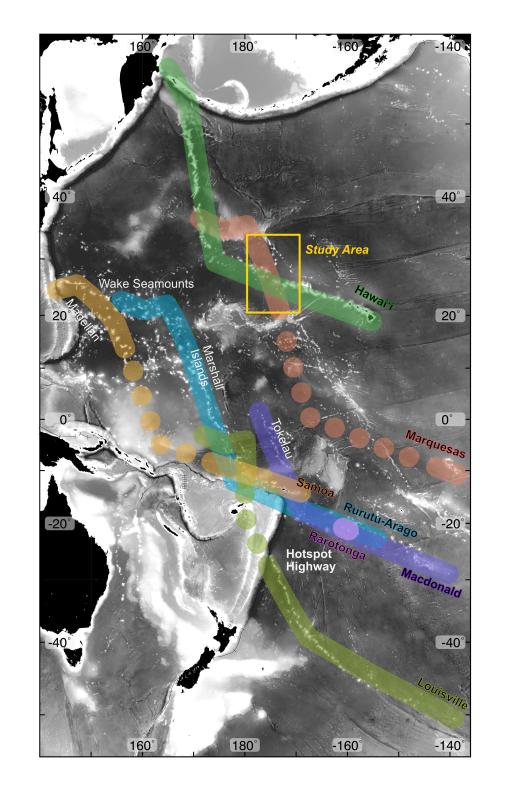
Sitting to my right, Dr. Val Finlayson, the genius, frenetic, and playful geologist leading our science objectives on this mission, carries us through deep geologic time as she explains the puzzle of the Pacific Basin, and invites us to consider the very making of the planet and ocean.
She, like the igneous rocks she studies and admires, is foundational to our team. Lovingly known as Dr. Isotope, Val helps us put together the puzzle of the Pacific Basin for ourselves, and connect the dots from ancient to contemporary mantle plume activity. We are descending upon a point on the seafloor that stands at the intersection of at least two mantle plume paths. What we now know to be the Hawaiian Islands have passed over one of the plumes for the past 28 million years; the other leaving several volcanoes on the seafloor 60 million years before.
On my left, Mahinalani Cavalieri brings me to tears as her poetic voice clarifies and reminds me of the distinction between Ao and Pō, the reverence and gratitude we owe to the Hawaiian Akua, Kanaloa, and the sacred realm of all ancestors and all future generations that we are traveling through together in Papahānaumokuākea.
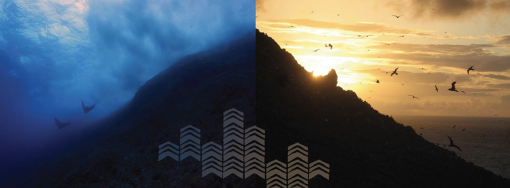
We entered the realm of all ancestors and all future generations when we crossed Ke Ala Polohiwa a Kāne and into Pō.
Without notice, and seemingly prompted by Kanaloa himself, she states live over Science Party Line (SPL), “We are the dreams of our ancestors.” We also share, sometimes spoken and often unspoken, the shared understanding that comes with voyaging together with our friends on our waʻa kaulua, or traditional double-hulled voyaging canoes.
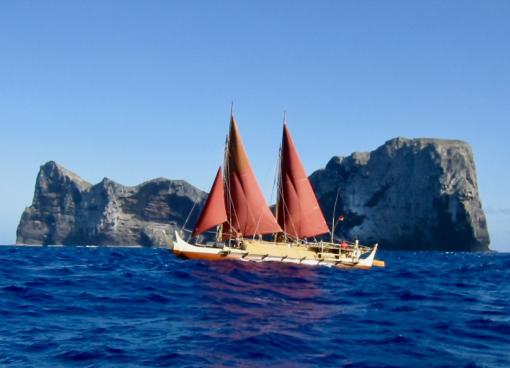
Pacific Peoples, including Hawaiians, have been on the path of deep sea travelers for thousands of years.
We are crewmates. Only days before embarking on this E/V Nautilus expedition, I was sleeping on the deck of Hōkūle’a in the waters between what is now known as Vancouver and Seattle, doing my small part to share in the Moananuiākea Voyage for Earth. Suddenly, I’m dancing between the waters of the Salish Sea and the far northwestern waters of the Hawaiian Islands, and realizing we’re held by one ocean, and the very same stars. And one another.
On the screen in front of me questions, comments, stories, species identifications, and occasional demands or complaints are pouring in from the hundreds and sometimes thousands of viewers who have joined us virtually. The ship has powerful telepresence capabilities and broadcasts all of our deep sea dives live for experts, students, teachers, and fans to follow along from home, office, or classroom. One viewer gripes about the keyboard clicks coming through the microphone. I push aside the distraction by coming onto the SPL and complimenting my amazing back row colleague and inspiring young Hawaiian, Kukui Gavagan - our data logger, and our light. I am reminded of her home island, Maui, and of our friends and family in Lahaina, and I am grateful that the future of Hawaiʻi has Kukui, Mahinalani, and those like them. Keep typing hard!
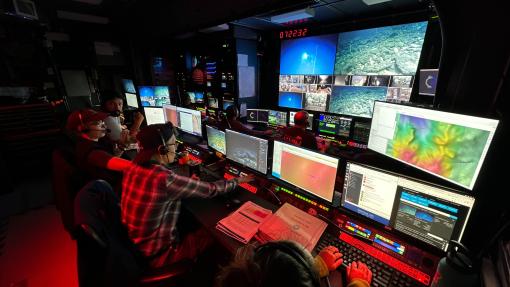
Our entrance into the Realm of Kanaloa is a triple-wide shipping container, all lights out, mobile control van on the top deck of E/V Nautilus.
It’s the big screens at the front of the van that most compel me. Looking through the eyes of Hercules and Atalanta, the deep sea comes into focus. My four 8-12 watch colleagues in front of me: Catalina Rubiano, our calm and capable navigator; Robert Waters, our legendary Hercules pilot; Zach Gonzalez, our trusty Atalanta pilot; and Amber Flynn, our incredible video engineer, are human extensions of the robots and bringing the deep sea safely to life for me, my back row colleagues, and the world to see. We have traveled through a portal into Papahānaumokuākea and the Realm of Kanaloa.
I see an ancient lava flow, fractured into four massive stones on the seafloor. With their smooth igneous faces, they make me think that the chamber to a forbidden world has been cracked open. I consider running away. I’m on a ship in the middle of the Pacific Ocean whose closest neighbors are the International Space Station. Where can I run to? A near-vertical wall emerges in front of us. It is covered in life. This place has never been seen by human eyes. Even our back row resident biological expert, deep-sea ecologist, and Ph.D. candidate, Virginia Biede, takes a break from identifying the dozens of species in view to marvel at what feels like the most precious of gifts. With nowhere to run to, I fall fully into the embrace of the deep sea and my fellow deep-sea travelers.

Ocean Explorer Daniel Kinzer and the 8-12 team slide to the edge of their seats and fall silent as they are transported through a deep sea portal.
We are a diverse team spanning generations, ethnicities, and many social and cultural backgrounds. Few of us had spent much time together before arriving at E/V Nautilus at the start of this expedition NA154, beautifully named Ala ‘Aumoana Kai Uli, or Path of the Deep Sea Traveler. But deep-sea traveling would make us fast friends. We all became more than our individual roles. We seemed more whole, made that way by each other and the deep sea. This is where we all come from and to where we all return.
There is no doubt. The scene is like something out of the Realm of Monsters in the Disney film Moana, or the more recent blockbuster film Avatar: The Way of Water. But this isn’t the shallows of Hollywood. These are the very real ocean depths, and yet they are a Dream. They surround me completely.
It doesn’t end when we leave the control van.
Tales of wild sea dreams percolate through the ship during meal time, in creating artwork, over puzzles, while watching films like Manō, between songs, and the sound of the ukulele on the social deck. They are still difficult to recall, but they leave a mark on the dreamer. They hint at the depths of knowledge and sacred secrets held within the deep ocean, and in our relationships to her, and to one another. In these dreams, we become shapeshifters, time travelers, space voyagers. We gathered with ancestors, and with future generations. We caromed off all of the feelings on the emotional highway. And we are not alone. Talk to many explorers, and especially ocean explorers, and you’ll hear similar tales. Going into the unknown of our beautiful Planet Ocean often comes with going into the unknown parts of our own minds and histories.
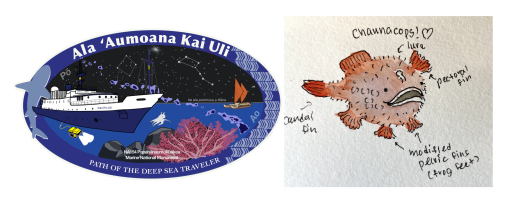
Left | This beautiful Ala ʻAumoana Kai Uli expedition emblem was created by ocean explorer, navigator, and mapper, Catalina Rubiano, to reflect the essence of our journey along the path of the deep sea traveler. Co-created with insights from the crew, and especially Kanaka ʻŌiwi on board, the emblem powerfully incorporates many cultural and scientific elements of the voyage. Right | Many teammates create and share their art as they process the incredible things we witness during our watches. This beautiful drawing was done by ocean explorer and Science Communication Fellow, Cara Lin.
"As Native Hawaiians, each of us has the ability to tap into a preconscious reservoir of past experiences and to access all that exists in a storehouse of knowledge called ancestral memories. Our lives are filled with opportunities and choices that can either allow or inhibit us from embarking on a path of remembering.” – Kekuewa Kikiloi
This seems to be an old way of thinking, often most accessible to children and remembered so well by the elders and ancestors. It comes to me in glimpses, and usually when I’m in deep communion with the natural world, and with water - with Kāne and Kanaloa. As a student of neuroscience and psychology, I couldn’t help but wonder what we’d find if we explored the depths of this old way of thinking the way that E/V Nautilus probes volcanoes, vents, and shipwrecks of the deep sea. What could the most advanced imaging technologies reveal to us about the experience going on in our minds while we enter into this dream-like portal provided by the depths of Papahānaumokuākea? As a student of biomimicry, or nature-inspired design, it strikes me as a rebranding of ancient ways of being; that it is primarily a practice of accessing this ‘storehouse of knowledge called ancestral memories’ when we make decisions about how to co-create the world around us. To be invited into this way of thinking, the magic and the science of it, feels like the real gift of this Ala ‘Aumoana Kai Uli expedition, the very real dream come to Life. It paints our ship to shores and those youth on the other side in a new light - they are the teachers and the inspiration. It brings my family and work - my ʻohana and hana - back in Ao, waiting for me back on land on Oʻahu, into deeper focus.
I'm writing this just hours before we'll descend into the depths for the twelfth and final time of the Ala ʻAumoana Kai Uli expedition. Our destination: the largest volcano on Planet Ocean, ʻŌnūnui/ʻŌnūiki (also known as Pūhāhonu, or Gardner Pinnacles).
One more dream!
We'll be headed back to port, and home for me, after that, arriving in Honolulu in just a few days. The rest of the crew will scatter, returning home and taking with them so much of the dream that we shared.
As I enter back into Ao, the realm of light, consciousness, and our daily lives, how can I bring this sacred experience and connection to family, friends, colleagues, and community? What questions will I return with? What old and new methods, tools, and technologies can help us reveal the stories of this expedition once we’re back on land? What relationships, new and old, will need my deeper attention and care? How can I share this gift with the many who might not otherwise have the opportunity to receive it? The gift I've received in Papahānaumokuākea is of the greatest kind; it comes with a significant kuleana - a privilege and responsibility - to share the lessons of this place and live out the dream more fully upon my return. These dreams belong to the ancestors and the children, and to all of us. To the ocean.
Ola i ke au a Kanaloa!
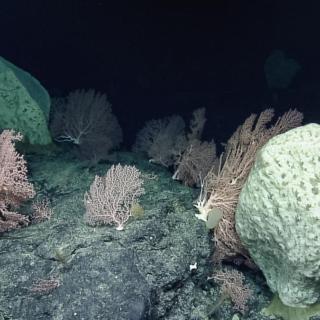
Ala ʻAumoana Kai Uli in Papahānaumokuākea Marine National Monument
Ocean Exploration Trust and partners will conduct a telepresence-enabled expedition to explore unseen deep-sea habitats aboard E/V Nautilus with ROV and seafloor mapping operations in the Papahānaumokuākea Marine National Monument (PMNM) focused on the largely unexplored northwestern section of the Monument.
